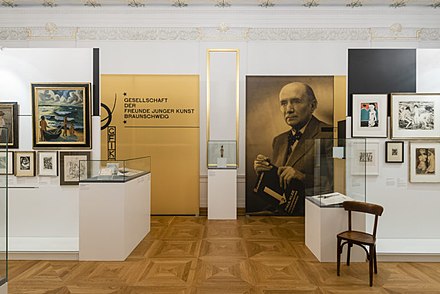Otto Ralfs

Otto Ralfs (* 1. April 1892 in Braunschweig ; † 13. December 1955 in Gifhorn ) a major collector of was art of classical modernism in Braunschweig.
Life
Otto Ralfs was the son of the Braunschweig hardware dealer Adolf Ralfs († January 1945 in Braunschweig). He attended the Real-Gymnasium in Braunschweig and the Wolterstorff Institute in Ballenstedt , then completed a commercial apprenticeship in Hanover. Professionally, he initially worked in his father's business, later as a branch manager of an iron wholesaler in Hamburg.
During the First World War , Ralfs was vice sergeant and reserve officer aspirant. After the end of the war, in 1919 he married Käte Brachvogel , a friend of his sister. On August 20, 1920 Ralfs founded the Braunschweiger Kanu Club .
In 1923 he discovered his inclination for modern art while visiting the Bauhaus in Weimar. In the same year, Ralfs had his first exhibition of "Modern Art" pictures in what was then the State Museum (now the Herzog Anton Ulrich Museum ). He made friends with artists such as Klee , Kandinsky , Feininger , Jawlensky and Maatsch and invited them regularly to Braunschweig. These visits resulted in his “famous guest book with artistic entries by important painters”, which is now in the holdings of the Municipal Museum .
In September 1924 Ralfs founded the Society of Friends of Young Art and became its 1st chairman. The first exhibition took place in the State Museum on November 16, 1924, and from March 1925 the company had a permanent exhibition room in Braunschweig Castle . The GFJK disbanded itself under pressure from the National Socialists in 1933.
In 1925, Ralfs founded the Klee Society , which set itself the goal of financially supporting the painter Paul Klee by buying up his works. It enabled the painter to make his second trip to the Orient from 1928–1929 to Egypt.
After the transfer of power to Adolf Hitler in 1933, the exhibition had to be stopped because of the charge of “ degenerate art ” and the Society of Friends of Young Art had to be dissolved.
In the bombing raid on Braunschweig on October 15, 1944 , Otto Ralfs' collection and thus one of the most important collections of modern art in Germany was destroyed. Only the guest book kept since 1923 was not destroyed.
After the Second World War , Ralfs founded the Otto Ralfs Gallery and continued exhibiting modern art from June 28, 1947 until his death.
family
Otto Ralfs was married to Käte Ralfs , b. Brachvogel (* July 8, 1898 in Braunschweig, † January 15, 1995 in Braunschweig), a friend of his sister and trained infant sister. The couple discovered the Bauhaus in Weimar for themselves and brought "its ideas of modern art to Braunschweig". "In order to help her husband with transports", Käte Ralfs then acquired the "driver's license for cars and trucks" in 1924. After Otto Ralfs had a fatal accident in 1955, his wife survived him by almost 40 years - in 1991 she was awarded the city of Braunschweig's medal for the special merits of the couple in promoting the fine arts .
literature
- Luitgard Camerer, Manfred Garzmann, Wolf-Dieter Schuegraf on behalf of the city of Braunschweig (ed.): Braunschweiger Stadtlexikon . 4th edition. Meyer, Braunschweig 1996, ISBN 3-926701-14-5 , pp. 187 .
- Manfred Garzmann, Wolf-Dieter Schuegraf on behalf of the city of Braunschweig (ed.): Braunschweiger Stadtlexikon - supplementary volume . 2nd Edition. Meyer, Braunschweig 1997, ISBN 3-926701-30-7 , pp. 108 .
- Richard Moderhack: Brunswick town history . Braunschweig 1997, ISBN 3-87884-050-0 , p. 198 .
Individual evidence
- ↑ Gerd Spies (Ed.): Braunschweig - The image of the city in 900 years. History and views. Volume 1, Städtisches Museum Braunschweig, Braunschweig 1985, p. 98
- ↑ Hinrich Bergmeier and Günter Katzenberger (eds.): Kulturaustreib. The influence of National Socialism on art and culture in Lower Saxony. A documentation for the exhibition of the same name . Hamburg: Dölling and Galitz 1993, ISBN 3-926174-70-6 , p. 83
Web links
- City chronicle of Braunschweig. In: braunschweig.de. City of Braunschweig, accessed December 31, 2008 .
- The Ralfs project - Braunschweig's handling of modern art 1920–1950. Theater Period, 2006, accessed December 31, 2008 .
| personal data | |
|---|---|
| SURNAME | Ralfs, Otto |
| BRIEF DESCRIPTION | German art collector |
| DATE OF BIRTH | April 1, 1892 |
| PLACE OF BIRTH | Braunschweig |
| DATE OF DEATH | December 13, 1955 |
| Place of death | Gifhorn |